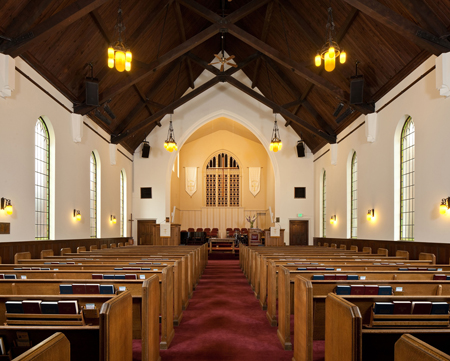Historical Preservation/Renovation

Bethany Presbyterian Church
seismic retrofit
Architect: SMR Architects
Owner: Bethany Presbyterian Church
Engineer: I.L. Gross Structural Engineers
ABC members: Clark Nuber; Merit Mechanical; NCM Contracting Group, ReNu Division; Propel Insurance; Reprographics Northwest; Pacific Fire & Security; S.M.E. Inc. of Seattle; Matheus Lumber Co.
Bethany Presbyterian is an iconic neighborhood church atop Queen Anne Hill. The neo-Gothic building -- with its sanctuary, bell tower and fellowship hall -- was built in 1929-30. All three elements are designated historic landmarks.
The church decided to make seismic upgrades after the 2001 Nisqually Earthquake. The first phase of this project was making the sanctuary and bell tower safe. Phase two, involving the fellowship hall (now classrooms and a day care), will begin this summer.
Rafn Co. teamed with SMR Architects and I.L. Gross Structural Engineers on the project. The team determined the most cost-effective approach to the installation of a seismic reinforcing system that would "magically" disappear into the existing structure.
Though plans existed for the original building, it soon became clear the original contractor took creative and sometimes curious liberties in just about every part of the building, which affected the seismic improvement design. One example was a mishmash of shapes and sizes of brick used for the exterior walls. Despite these obstacles, Rafn's preconstruction service uncovered all of the major structural issues before construction began. Change costs resulting from unknown structural issues were less than 2.5 percent of construction cost.
Integrating new structures into the existing ones was paramount to the success of the project. To support the elegant exposed timber truss roof without changing the appearance of the unreinforced masonry walls, Rafn used the typical seismic improvement elements, hollowed out the masonry walls and cast new concrete columns to collect the load of the trusses. Then a concrete tie beam at the roof eave level connected all the columns together, creating a concrete frame inside the existing walls. Temporary shoring towers were used to support the roof during construction.
The bell tower was originally built as a concrete post-and-beam frame with masonry wall infill. Rafn added shotcrete shear walls to tie the old concrete frame together and tie the masonry to the new walls. Stainless steel cable "leashes" were installed on the tower's gargoyles to hold them in place in case they ever broke off. The roof was also replaced using structural insulated panels, which insulate the sanctuary without covering the exposed wood ceiling.
By self-performing more than 40 percent of the work, Rafn had greater flexibility to meet the construction schedule and realized more than $26,000 in cost savings. The project was finished on schedule and under budget. There were no time-loss accidents during the nearly 12,000 work hours.